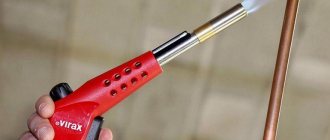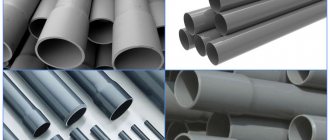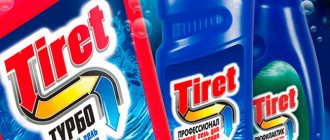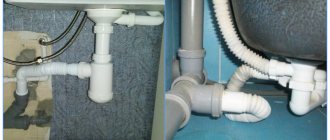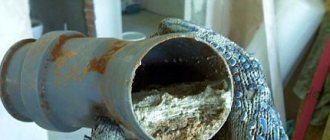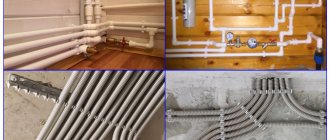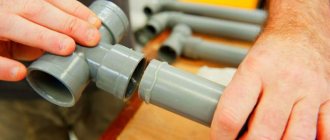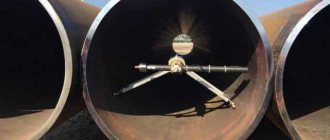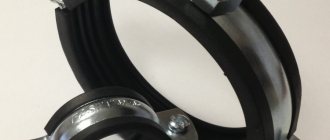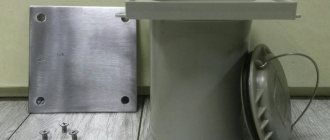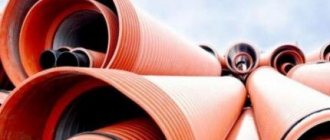Polymer products are replacing metal and ceramic pipes. They are becoming increasingly popular due to their obvious advantages - durability, lightness, resistance to corrosion and the effects of aggressive substances. If handled with care, a plastic pipeline can last at least half a century.
The main thing is to ensure high-quality, hermetically sealed joining of elements. To assemble the parts, use a special glue for PVC pipes. The so-called “cold welding” allows you to build a water supply system with minimal labor costs. However, the use of glue has a number of nuances that must be studied before starting work.
The article outlines the advantages of the adhesive method of joining plastic pipes, provides an overview of the best manufacturers, and also provides recommendations for choosing the appropriate composition. Step-by-step instructions for gluing PVC products will help you assemble the pipeline yourself and avoid possible mistakes.
Advantages of adhesive pipe joints
Polymer pipes are welded, glued or mechanically connected to each other. The first method is the most popular. For welding, special equipment and nozzles selected according to the diameter of the pipeline are used.
It is better to entrust such work to professional craftsmen. An option is to rent or buy a welding machine. It's expensive, but it will help you learn another useful skill.
Materials for polymer pipelines are safe. They do not emit toxins into the atmosphere, do not enter into chemical reactions, so they can be safely used for the installation of water supply and sewer systems
The glue connection method is less common, but no less effective. It is commonly called “cold welding”. Adhesive seams are just as (and sometimes even more) reliable as welded ones.
The only caveat: almost all types of adhesives for plastic pipes are designed for cold water supply systems and can quickly lose their properties when exposed to high temperatures.
Polymer pipelines with adhesive joints remain absolutely smooth from the inside. There is no damage or roughness on the surfaces, which could cause blockages in the future (+)
Advantages of gluing PVC pipes using special compositions:
- Reducing the risk of leaks . When gluing sections of pipeline, the parts are connected at the molecular level. The seams are absolutely sealed, and they can only begin to leak under the influence of high temperature or pressure.
- Minimum labor costs . Gluing pipes does not require any additional complex processes. This is a simple method that does not require special skills.
- Fast and cheap installation . All operations can be performed with your own hands. You just need to buy the materials and choose the right adhesive composition. No need to look for a welding machine.
- Low energy consumption . The machine for welding polymer pipes runs on electricity, and no equipment is required for gluing parts. This is additional savings on materials and energy resources.
- Versatility . The method is suitable for connecting pipeline parts of any diameter - from 6 to 400 mm. It can be used when installing water supply and sewer systems.
Cold welding is a cheap and convenient way to install a pipeline. To use it, you do not need anything that could lead to an increase in the cost of work: you do not have to spend money on additional connecting elements or special equipment.
Taking into account the low cost of the polymer pipes and adhesives themselves, piping systems are relatively cheap and can be installed in a matter of days
The principle of operation of all types of glue for polypropylene pipes is approximately the same. The compositions partially dissolve polyvinyl chloride and firmly bind the particles.
The compositions contain additives that improve adhesion. When gluing, the solvent quickly evaporates, and the composition hardens and gains strength. The result is a high-strength connection.
The connection with glue is hermetically sealed, but for greater reliability you can use a combined method of attaching pipes - with adhesive and fittings
On the market you can find products for creating high-strength joints from both foreign and domestic manufacturers.
Specifications
The abbreviation PVC is a shortened version of the spelling of the word “polyvinyl chloride,” identifying an environmentally friendly polymer with a low melting point and low frost resistance. It is worth noting that the last two not very attractive properties are compensated by the high stability and the same mechanical strength of this material. Actually, its physical characteristics give the PVC pipe the following qualities:
- exceptional ring rigidity. The product is not afraid of water hammer and can withstand pressure up to 120 atmospheres;
- excellent indicator of resistance to temperature deformation. When the temperature reaches the maximum permissible level, the pipe dimensions will increase by only 5%;
- poor heat resistance. The loss of rigidity of an adhesive polyvinyl chloride pipe is recorded at a temperature of +78˚C. Therefore, it is not allowed to use this product when creating pipelines with a working environment temperature exceeding +40˚С ;
- fear of low temperatures. Polyvinyl chloride can withstand cooling without irreversible changes in its structure only down to -15˚C. Accordingly, if it is planned to operate a PVC pipeline in regions where such a temperature indicator is not uncommon, the plastic pipeline must be insulated.
The following points are worth highlighting from the operational characteristics:
- long period of operation without the need for cleaning. The high smoothness of the internal surface prevents siltation and clogging of utility lines;
- ideal for installing sewerage systems. This is due, again, to the smooth inner surface and small wall thickness;
- durability. One of the main reasons for this property of adhesive PVC pipes is the excellent resistance of the polymer to UV radiation.
Adhesive PVC pipes are available in different sizes and are used for water supply and sewerage systems
Review of the best brands
In all ratings of adhesives for PVC pipes, the leading brands are Tangit (Germany), Genova (USA), Griffon (Netherlands), Gebsoplast (France). Buyers speak well of the adhesives “Phoenix” , “Vinilit”, “Mars” and others, but they are not so in demand and popular.
All types of glue for polymer pipes operate on the same principle, are available in packages of various sizes, and the appropriate composition should be selected depending on the purpose and technical characteristics.
Image gallery
Photo from
Reliable “pair” - glue and Tangit solvent
Genova glue - composition from the pipe manufacturer
Griffon universal adhesive in 1 liter package
Gebsoplast adhesive for water supply and sewerage
Areas of use
The scope of application of adhesive PVC pipelines depends on their physical and chemical characteristics; the products are used for the installation of communications in the following areas:
- Construction of swimming pools. Adhesive PVC pipes are widely used in the construction of water supply and purification systems in swimming pools. Due to the tightness of the joints and the high anti-corrosion characteristics that polyvinyl chloride has, such pipes are most suitable when working with chlorinated water.
- Air conditioning, cooling systems. PVC adhesive pipes are suitable for transporting liquid low-temperature and aggressive substances, such as refrigerant, chlorine, and so on during the construction of industrial air conditioning units, chillers, coolers.
- Laying pressure sewer. The average consumer is well aware of the sewerage system that is installed in apartments and country houses. It is assembled using the socket method, inserting pipes into each other, while sealing is ensured by internal rubber rings mounted in the expanded pipes. This type of installation does not withstand high pressure of the liquid working medium, which cannot be said about the sewer line assembled by gluing. Most often, adhesive sewer PVC pipes are laid in swimming pools and water parks to move large volumes of water at high speed.
- Water purification and preparation systems. Due to the resistance of polyvinyl chloride to solutions with a high percentage of various types and concentrated sulfuric acids, sodium hypochlorite, demineralized and deionized water, PVC pipes are widely used in the workshops of water treatment plants.
- Chemical industry. Glued PVC pipelines are installed at chemical plants to transport aggressive liquids - mineral acids, alkalis, solutions of salts, oils, fats, gasoline without the presence of benzene.
Rice. 2 Examples of using glued PVC pipes
- Agriculture. Glued PVC pipes are used to assemble greenhouse piping - drip irrigation systems, pipeline units for supplying solutions with fertilizers. In livestock farming, polyvinyl chloride is used to assemble engineering structures for the delivery of feed and drinking water, and manure removal.
- Cold and hot water supply systems. Almost all adhesive PVC pipes and fittings are designed for use in temperatures up to +60 °C, so they are used to supply cold water. In pipelines with a high-temperature working environment, pipelines made of chlorinated polyvinyl chloride CPVC, which have a higher temperature resistance of up to +95 ° C, are used.
- In air supply systems. Since the glued joint provides a high degree of tightness of the pipeline, PVC pipes are often used for installing natural or forced ventilation.
Rice. 3 Shaped PVC parts for gluing
Rules for working with adhesives
When working with glue, you should always read the manufacturer's recommendations. Many compounds cannot be left open for more than a few minutes, because... they set quickly, making their further use difficult. The average time during which the glue can remain open is 4-5 minutes.
In summer and winter, the compositions harden the fastest: at high ambient temperatures, the glue may become unusable after 1-2 minutes, and at low temperatures, the viscosity increases. Therefore, you should pay attention to the manufacturer’s instructions regarding operating temperature conditions.
When purchasing a specific brand of glue, you should pay attention to its preparation for use. Some types are easy enough to mix, but two-component compositions have to be combined correctly and their consistency must be monitored.
There is a risk of incorrect mixing, which leads to loss or change in adhesive properties.
You should pay attention to the solvent for degreasing surfaces. It is best to choose a composition from the same company as the glue. Even if the packaging of the adhesive composition states that degreasing is not necessary, it still makes sense to wipe the surfaces to be glued with a high-quality solvent.
Color and viscosity matter. Experienced plumbers prefer compositions of medium viscosity. They are easy to apply, and when joining parts, such glue does not spread, so you do not have to remove it with napkins.
As for color, the colorless composition is suitable for white and colored pipes. It is not visible, even if the drops protrude beyond the glued area and freeze.
Gluing process
Having sorted out the choice, let's look at how to seal a sewer pipe. This procedure is carried out in accordance with the instructions on the package. Different compositions can be used, for which there are different gluing methods. General rules for performing work:
- it is necessary to ensure air circulation, since some types of glue emit a pungent odor;
- prepare tools for cutting pipes, cleaning surfaces, applying compounds;
- prepare material for degreasing the surfaces to be joined.
The system is assembled in stages:
- cutting pipes, dry fitting of the system, adjusting the length of parts;
- cleaning and degreasing surfaces. To do this, use a tampon or brush. The material is acetone or special compounds;
- applying glue to the inner surface of the socket (sometimes applied simultaneously to both surfaces to be glued);
- installation of connecting elements into the socket, temporary fixation in a stationary position.
Assembly can be done without stopping, but water can be turned on no earlier than after 24 hours. During this time, the glue will harden and the seam will be ready for work.
Criteria for choosing pipes and type of glue
When purchasing pipes and fittings, pay attention to the purpose of the products, diameter, and wall thickness of the products. The brand is of fundamental importance.
A good brand is not only money invested in advertising, but also real quality, thanks to which the product does not lose its position in the market. It is always better to choose reliable manufacturers, even if their products are a little more expensive than unknown analogues.
Pay attention to the markings. It indicates many technical and operational characteristics: diameter, nominal pressure, purpose and scope of application of pipes (+)
When choosing components, it is worth reading the technical documentation, which indicates the purpose of the product, the temperature conditions at which it remains functional, the safety margin and service life, and the manufacturer’s warranty.
You should carefully examine the pipes and fittings. Their internal and external surfaces must be smooth, and their structure must be uniform, without signs of delamination, streaks, cracks or other defects.
The condition of the packaging indicates how the product was loaded, unloaded, transported and stored. If its appearance leaves much to be desired, you should once again make sure that the pipes themselves are not damaged
When purchasing glue, consider not only the characteristics of the composition itself, but also the following nuances:
- Pipeline installation location . Working conditions in different areas can be very different in terms of the degree of contamination, the temperature of the liquid in the pipes or the environment, and other important parameters. It is possible that adhesive compositions will have to be selected separately for different zones.
- Fluid pressure. All manufacturers make sure that there are no unnecessary claims against them from customers, so they must indicate what pressure the pipe glued with their compound can withstand. The higher this characteristic, the more reliable and expensive the glue. Saving is irrational. It is necessary to compare the pressure in the water supply with the value indicated on the glue packaging.
- Features of loads . Often, pipelines can move due to mechanical stress from the outside or due to pressure from the inside. If severe shear loads are possible at the joint, a more durable adhesive should be selected.
- Temperature regime . Some types of glue are excellent for arranging a cold water system, but will be ineffective for a sewer pipeline, because... the temperature of the wastewater is different.
When choosing an adhesive, it is important to take into account the characteristics of the compositions. They usually contain volatile toxic substances. People prone to allergies are better off not working with toxins: they will either have to entrust the installation of the pipeline to specialists, or choose another method of connecting the parts.
Adhesives for plastic pipes should be worked outdoors or in well-ventilated areas, where access to unauthorized people, children and pets should be prohibited.
Pipes, fittings, and adhesives should only be purchased at specialized retail outlets. You should not save money by choosing “the same” products on a spontaneous market.
Popular products are often counterfeited, so it is better to contact sellers with a good reputation who monitor the reliability of their suppliers and are ready to provide guarantees or exchange low-quality goods.
Methods and means for repairing PVC pipelines
During pipeline operation or installation work, it is impossible to completely eliminate the possibility of leaks. In this case, you need to find a solution for urgent repair of products or restoration of tightness in connecting nodes. Let's consider which adhesive or sealant for polypropylene is suitable for such purposes.
Leakage in the hub connection with the fitting Source tumentoday.ru
Causes and consequences of leaks
Identifying root causes is often helpful in finding problems and solutions. More often this is a depressurization of the connecting seam. To prevent or minimize the risks of “gaps” appearing, you need to monitor:
- temperature conditions during the soldering process;
- degree of reliability of fixation of nut fasteners or crimp fittings;
- correct preparation of elements for soldering, welding or other connections (cut angle, evenness of edges, cleanliness of walls);
- the applicability of the adhesive for a specific section of the pipeline;
- admissibility of the use of sealing and sealing materials.
It is not difficult to identify problems in polymer pipelines in a timely manner. In places of depressurization, condensation (dew), leaks appear, or the pressure in the system changes downwards. Without urgent intervention, the situation may turn out to be an emergency. This applies not only to the water supply or sewerage system itself, but to neighboring premises, apartments, houses, furniture and interior items, household appliances, and electrical wiring.
Consequences of failure to detect a leak in a timely manner Source ytimg.com
Review of methods and materials for pipeline repair or restoration
The action algorithm includes three stages: turning off the water, troubleshooting, testing the system for serviceability. Only after this can you return to full operation of communications.
To stop the transportation of liquid, it is not always necessary to turn off the central riser in a particular house. Today, plumbers are trying to create separate circuits or bypasses by integrating shut-off valves or tap fittings into the system. This way, it will be possible to de-energize only part of the pipeline and continue to use the rest as before.
Before carrying out restoration measures, you need to decide how to seal the plastic water pipe. Here are the main criteria for choosing funds:
- efficiency;
- performance;
- ease of use.
More often, connections of polymer products are made with the creation of conditions for polymerization. In this case, it is impossible to disassemble the monolithic assembly and create it back. Therefore, it is necessary to cut out part of the contour and insert a new one using a similar technology (which was used previously).
Replacing a damaged section of a pipeline Source homify.com
Step-by-step instructions for using the composition
Before you start gluing plastic pipes, you should make sure that there is normal air circulation in the room and the temperature is between 5-35°C.
In addition to materials, the work will require some tools:
- for marking - marker and measuring tools;
- for cutting pipes - pipe cutters, jigsaw or hacksaw;
- for cleaning surfaces - sandpaper;
- for degreasing – solvent;
- to apply the composition - the glue itself, a brush made of natural bristles (some glues, including Tangit, are immediately equipped with a suitable brush) or a glue gun.
Surface preparation is an extremely important stage in gluing parts. They should be perfectly smooth and fat-free. If contaminants remain on the pipe, the glue will only stick on top of them and form a film, but there will be poor contact with the surface itself. This may cause leaks to develop over time.
PVC pipes are prepared for upcoming gluing in several steps:
Image gallery
Photo from
Step 1: Purchase socket fittings
Step 2: Fitting and marking pipes
Step 3: Marking pipes for preparation
Step 4: Cold Welding Rules
Pipeline bonding technology:
- Pipe marking . Before starting the installation of the pipeline, a design and detailed diagram must be prepared. The pipes are measured and marked using them.
- Cutting pipes . The next stage is preparing sections of the required length. It is best to use pipe cutters, but other tools will work. The main thing is that the cutting areas are level. The edges are cleaned with sandpaper.
- Bonding system elements . The most convenient way is a glue gun. With its help, you can evenly and accurately distribute the composition over the surface. If you don't have a gun, you should use a brush. The glue is applied so that in the selected area there are no areas free from it.
- Connecting parts . To connect, the system elements are pressed against each other for at least 20-30 seconds. During this time, the composition thickens and becomes more viscous. Then the part can be put aside for a day. It is important that the compression force is sufficient, otherwise the joint may leak during operation.
- Pipe cleaning . No matter how carefully the glue is applied, it may extend beyond the intended area. It is removed immediately before it hardens. A damp cloth, rag or sponge is suitable for this.
- Polymerization of the composition . It takes 20-24 hours for the glue to harden, so it is better not to touch the system before. You cannot move, separate or reconnect parts, or run water through pipes.
When the glue polymerization process is complete, you should check the efficiency of the system. It is launched in operating mode and all joints are carefully examined.
If it doesn't leak anywhere, everything is fine. If leaks are detected, the connections are additionally sealed.
Image gallery
Photo from
Stage 1 – straight cutting of the pipe
Stage 2 - chamfering the pipe
Stage 3 - applying adhesive composition
Stage 4 – process of gluing parts
An important nuance: when gluing parts you need to work extremely clearly. The pipeline section is inserted into the fitting in one motion. It should not be sharp, but fast. When the pipe is inserted, it should not be wiggled or twisted so as not to reduce the strength of the connection.
Classification
All PVC fittings can be divided according to installation method into:
- adhesive (cold welding);
- threaded;
- flanged.
A large group consists of combined parts that combine two different connection methods. For example, adhesive and flange, adhesive and threaded. Fittings are not used for high-temperature welding of polyvinyl chloride pipes. This connection method is used on large-diameter pipelines in industrial construction. Butt welding is carried out using professional, expensive equipment.
PVC fittings allow you to mount metal shut-off valves into a plastic system, connect a polymer segment of a water pipeline with a metal one, and make the transition from one diameter to another.
According to the manufacturing method, PVC fittings are divided into cast and segmented. Cast parts have a one-piece body. During their production process, molten polymer is poured into a finished mold, where it cools and hardens. The resulting part does not have connecting seams on the body. Segmented ones are assembled from blanks, gluing them together during the production process. Cast fittings are more resistant to mechanical pressure.
According to the performance characteristics, PVC materials are divided into:
- pressure, intended for water supply systems;
- non-pressure – sewerage, storm drains, installation of electrical networks;
- for rarefied environments.
According to their purpose, PVC fittings can be divided into three large groups:
- Connecting. This includes adhesive, threaded, and flange couplings, which are used to connect straight sections of a pipeline.
- Branching - straight and angled tees, crosses.
- Regulating – shut-off valves, plugs.
For installation of turns, manufacturers offer corners with a large turning radius. They avoid sewer blockages that are typical for sharp turning points (starting from a right angle).
American coupling
The American coupling is a popular type of plastic combined fittings that allows you to mount both a straight joint and a corner connection. A distinctive feature of the American one (the connection method was invented by the Americans) is the union nut, which allows you to mount a high-strength detachable connection. It is convenient to use an American coupling in the installation of hard-to-reach areas.
